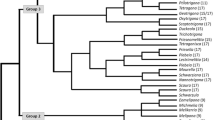Abstract
The phylogenetical relationship of the fleas (Aphaniptera=Siphonaptera) to the other orders of the Insecta remains unsolved. Comparative studies of the cytology of the fleas are undertaken in an attempt to elucidate this problem. Two populations of Xenopsylla cheopis Rothschild, 1903, exhibit a chromosome complement of 2n = 14 A + X1X2Y (male): 14 A+X1X1X2X2 (female). The X1X2Y-sex-trivalent is restricted to the male meiosis, in oogenesis two sex-bivalents (X1X1 and X2X2) are formed. One population of Leptopsylla segnis Schönherr, 1811 shows 2n =18 A + XY (male): 18 A+XX (female).
The high chromosome number of X. cheopis, L. segnis, and N. fasciatus (Bayreuther, 1969), the diffuse premeiotic stage in the spermatogenesis of the threespecies investigated and the multiple sex-chromosome-mechanisms of X. cheopis and N. fasciatus do not support the concept of a closer phylogenetic relationship between the Aphaniptera and Nematocera, but do not preclude the possibility of a kinship of Aphaniptera and Neomecoptera. Additional studies of the cytogenetics of these two orders are required before lasting conclusions can be drawn. The analysis of the chromosome cytology of the fleas of the Marsupialia, which are considered to be the most primitive of all living forms, could prove particularly instructive.
Zusammenfassung
-
1.
Die phylogenetischen Verwandtschaftsbeziehungen der Flöhe (Aphaniptera = Siphonaptera) zu den anderen Ordnungen der Insekten sind ungeklärt. Vergleichende cytogenetische Untersuchungen bei den Flöhen werden unternommen, um diese Frage aufklären zu helfen.
-
2.
Eine Hamburger und eine Londoner Population des Pestflohes Xenopsylla cheopis Rothschild, 1903, haben einen Chromosomenbestand von 2n = 14 A + X1X2Y (Männchen) und 14A + X1X1X2X2(Weibchen). Das X1X2Y-Geschlechtstrivalent ist auf die männliche Meiose beschränkt, in der Oogenese treten 2 Geschlechtsbivalente (X1X1 und X2X2) auf.
-
3.
Eine Plochinger Population des Hausmausflohes Leptopsylla segnis Schönherr, 1811, zeigt 2n = 18 A + XY (Männchen): 18 A + XX (Weibchen) Chromosomen.
-
4.
Die cytogenetischen Befunde sprechen gegen eine nähere phylogenetische Beziehung zwischen Aphaniptera und Nematocera. Sie widersprechen nicht den neueren Vorstellungen von einer näheren phylogenetischen Verwandtschaft zwischen den Aphaniptera und Neomecoptera.
-
5.
Weitere Untersuchungen der Chromosomen der Aphaniptera und Neomecoptera sind jedoch notwendig, bevor beständigere Aussagen gemacht werden können. Die Analyse der Chromosomencytologie der Flöhe der Marsupialia, welche als die ursprünglichsten von allen lebenden Formen angesehen werden, könnte besonders aufschlußreich sein.
Similar content being viewed by others
Literatur
Bayreuther, K.: Extrachromosomales DNS-haltiges Material in der Oogenese der Flöhe. Z. Naturforsch. 12b, 458–461 (1957).
—: Die Cytogenetik zweier norddeutscher Populationen von Nosopsyllus fasciatus Bosc (Aphaniptera). Chromosoma (Berl.) 27, 20–46 (1969).
Cooper, K. W.: Compound sex chromosomes with anaphasic precocity in the male mecopteran Boreus brumalis Fitch. J. Morph. 89, 37–57 (1951).
Crampton, G. C.: A phylogenetic study of the posterior metathoracic and basal abdominal structure of insects, with particular reference to the holometabola. J. N. Y. entomol. Soc. 39, 323–347 (1931).
Hennig, W.: Die Stammesgeschichte der Insekten. Wald. Kramer, Frankfurt, Senckenberg-Buch 49 (1969).
Hinton, H. E.: The phylogeny of the panorpoid orders. Ann. Rev. Entom. 3, 181–206 (1958).
Karnkowska, Z.: Les chromosomes dans la spermatogénèse de la puce. C. R. Soc. Biol. (Paris) 110, 670–671 (1932a).
— Les chromosomes de la puce (Leptopsylla musculi Dugès). Soc. vaud. Sci. natur. 57, 591 (1932b).
Payne, F.: The chromosomes of Gryllotalpa borealis Burm. Arch. Zellforsch. 9, 141–148 (1912).
—: A study of the germ cells of Gryllotalpa borealis and Gryllotalpa vulgaris. J. Morph. 28, 287–327 (1916).
Riek, E. F.: Lower cretaceous fleas. Nature (Lond.) 227, 746–747 (1970).
Ross, H. H.: A textbook of entomology, 3rd ed. New York: Wiley Press (1965).
Schrader, F., Leuchtenberger, C.: A cytochemical analysis of the functional interrelationship of various cell structures in Arvelius albopunctatus (de Geer). Exp. Cell Res. 1, 421–452 (1950).
Tillyard, R. J.: The evolution of the scorpion-flies and their derivates (Order Mecoptera). Ann. entomal. Soc. Amer. 28, 1–45 (1935).
Wagner, J.: Aphaniptera. Bronns Klassen und Ordnungen des Tierreiches. 5. Band, 3. Abteilung, 13. Buch, Teil f, S. l-114. Leipzig: Akad. Verlags-Gesellschaft (1939).
White, M. J. D.: Cytogenetics of orthopteroid insects. Advanc. Genet. 4, 267–330 (1951).
—: Cytogenetics and systematic entomology. Ann. Rev. Entom. 2, 71–91 (1957).
Author information
Authors and Affiliations
Rights and permissions
About this article
Cite this article
Bayreuther, K., Bräuning, S. Die Cytogenetik der Flöhe (Aphaniptera). Chromosoma 33, 19–29 (1971). https://doi.org/10.1007/BF00326380
Received:
Accepted:
Issue Date:
DOI: https://doi.org/10.1007/BF00326380




